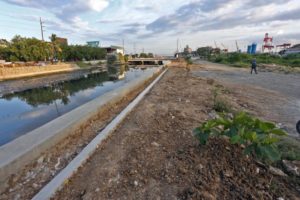
The eco-pavers will be used to build a pathway and a bike lane along the banks of Mahiga Creek.
The eco-pavers will be used to build a pathway and a bike lane along the banks of Mahiga Creek.
If plans don’t fall through, part of the 5.2-kilometer Mahiga Creek will soon be a sight to behold.
The largely polluted body of water, which traverses through several villages of Cebu and Mandaue and serves as the boundary between the two cities, may soon have frequent visitors strolling its riverbanks at the side of barangay Mabolo in the North Reclamation Area (NRA).
A garden, a pathway, and possibly a bike lane will be built by the Cebu City Environment and Natural Resources Office (Ccenro) in that area in line with the agency’s task to rehabilitate the city’s creeks and waterways.
For starters, Ccenro has completed over 2,000 eco-pavers produced by its workers since May.
The eco-pavers are bricks made of glass shards collected from the city’s garbage and mixed with concrete.
“We’re showcasing our work done in Mahiga Creek this November 12,” said Ccenro chief, Ma. Nida Cabrera as Cebu prepares to host the International River Summit which will be held in Mandaue City from Nov. 22-24.
“Right now, we’re doing landscape works in the area to place our eco-pavers,” added Cabrera in an interview with Cebu Daily News.
A ceremonial unveiling of the beautification project will be held days before the summit to showcase the ongoing river rehabilitation work.
Earlier, Ccenro, with the help of the city’s Prevention Restoration Order Beautification Enhancement (PROBE) team, managed to reclaim the creek’s three-meter easement zone from settlers living by the river.
“We finally cleared the area from illegal settlers,” announced Cabrera.
The eco-pavers will be used to build a pathway and a bike lane along the banks of Mahiga Creek while ornamental plants will be cultivated in the area to make it more appealing.
Cabrera explained that Ccenro chose Mahiga as the pilot river for their enhancement project since it is one of the city’s major waterways.
“After we can showcase the rehabilitation we’ve done in Mahiga Creek, we will be coordinating with other barangays especially those with river systems in their jurisdiction,” she said.
The Cebu City government, said Cabrera, wants to show to the public the practice of recycling materials.
“We made sure that in our projects on rehabilitating the rivers, we will be using recyclable materials as a means to tell them how to address plastic pollution,” Cabrera said.
Aside from the eco-pavers, Ccenro also initiated a biofence project made from recycled plastic water bottles wired together and designed to swing loosely under water to form a barrier to prevent trash from floating into the sea.
Each of the biofence is about ten meters long and half-a-meter wide and cost the city around P800 to make.
The biofences were installed in three waterways — the Tinago Promenade of Barangays San Roque and Tinago, the creek beside Tejero barangay hall, and the fish port in Barangays Pasil and Suba.
Soon, Mahiga Creek will also have a biofence to trap garbage from entering its waters.
According to Cabrera, the biofences helped garbage collectors from the Department of Public Service (DPS) to clean the rivers of trash.
Twenty six tons of garbage were collected from the biofences within a month.
“We are glad to see the efficiency of our bio-fence but as of now, we are in need of more plastic bottles to create more especially that a lot of barangays have also requested for them,” she said.